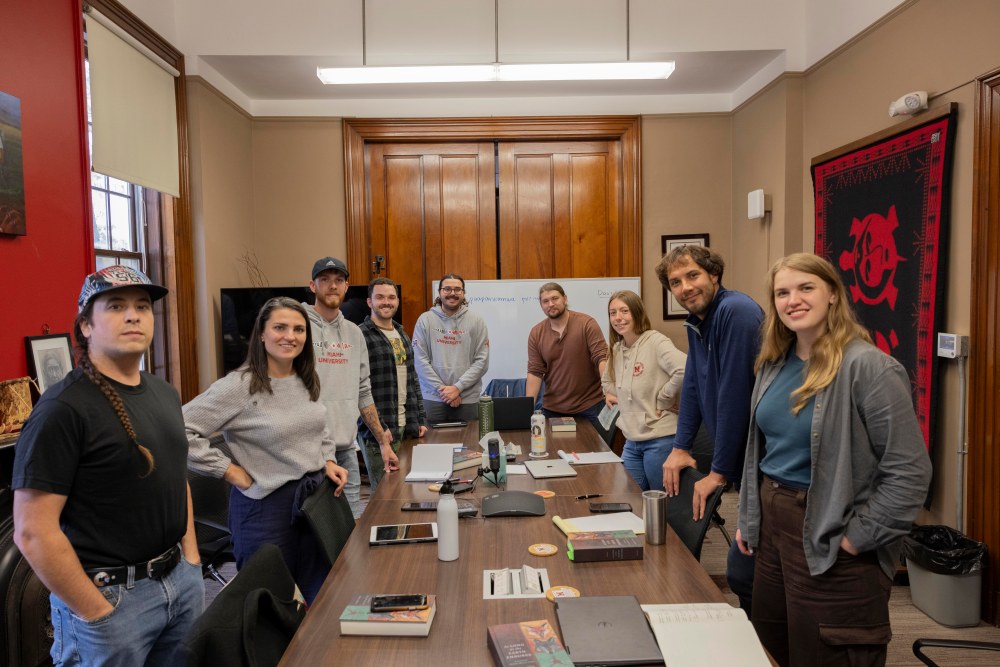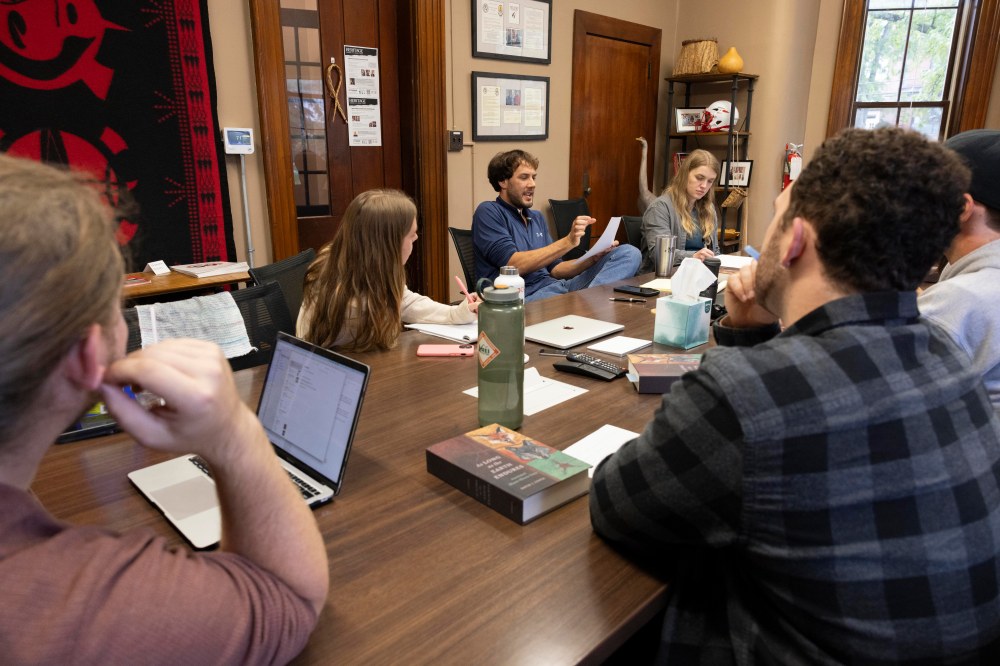Last semester at Miami University, I held an independent study for students interested in Myaamia storytelling. The goal of the course was for each student to tell Aalhsoohkaani ‘a Winter Story’ or aacimooni ‘a historical narrative’ to the Myaamia Heritage class at the end of the semester. Through the process of learning a story, they would also learn Myaamiaataweenki. Each participant chose their own story from one of 46 found in David Costa’s recently released book “As Long As The Earth Endures: Annotated Miami-Illinois Texts”.
We had a mix of seven students and staff participating in this course:
Undergraduate students: Elliot Baldwin (awansaapia), Kaleb McMullen and Caleb Collins. Graduate students: Jared Nally (ahsapa) and Madison Bastress.
Myaamia Center staff: Stella Beerman (akooka) and Haley Shea (kiišikohkwa).

These students spent a semester studying the stories on their own time through a variety of different strategies (flashcards, writing the story down verbatim, etc.) and participating in classes each week where we used the stories as a basis for learning Myaamiaataweenki. I interviewed a few of them so we could hear what they learned and how it impacted them.
Madison
Madison was the exception in class in that she is not Myaamia and had no prior experience with Myaamiaataweenki. As a visiting scholar from NYU, she thought it would be useful (and fun!) to participate in the storytelling course to help to give her a better understanding of Myaamiaataweenki in a way that could help her with her dissertation work. She chose an aacimooni because she felt it was more appropriate since she was not Myaamia and had not heard or told any Myaamia stories before. Originally she chose a speech by Mihšihkinaahkwa ‘Little Turtle,’ but after some time working on it, she decided to switch to something more manageable (aka shorter) that she could have ready for the storytelling event. Her final story was a text on step-by-step instructions for tanning a buckskin by Sarah Wadsworth. This tied into a community program connected to the Reclaiming Stories Project she participated in over the summer involving brain tanning a hide.
The class was difficult for her because she was playing catch-up compared to the other students who knew at least a little Myaamiaataweenki, but she said the class was structured in a way that was adaptable to all the different language abilities present. One of her favorite parts of the class was leading the immersion sessions. This was a weekly activity that involved everyday objects (phone, keys, wallet, etc.) on the table in front of the group. Everyone learned the names of the objects, how to describe them, and interactions with the objects and the other people. Each session involved taking turns leading, which meant asking questions about the objects (ex. How many keys do you have?), giving commands (ex. Give two pens to awansaapia!), etc. Another part of the course she enjoyed was story translation. Using a story I wrote, we each took turns reading a sentence from the story then translating it and discussing it.
Elliot (awansaapia):
Awansaapia chose the Aalhsoohkaani about Paapankamwa and Mahweewa ‘Fox and Wolf’ with the ending of Mahweewa drowning himself trying to find Paapankamwa. He grew up hearing that story and he’s always liked it so that was what made him want to tell it in Myaamiaataweenki. Knowing the English version of the story helped him learn the Myaamia because it allowed him to know where in the story he was and, as he learned pieces of the Myaamia, he could anchor to those during the telling. He has wanted to learn an Aalhsoohkaani but it’s difficult to do on your own. Being in a class with a storytelling focus held him accountable and made it more fun because the rest of the group was going through the same thing.
Stella (akooka):
Akooka also chose a Paapankamwa and Mahweewa story and teamed up with Awansaapia and Kiišikohkwa to tell one story, due to its length. The parts of the class she enjoyed the most were the activities that did not relate to the story. She said they allowed her to take a break from her daily story practice while still learning Myaamiaataweenki, just in a different context. When it came time to tell the story, she said she was nervous because of the public speaking, but proud to do it, especially in front of other Myaamiaki. It was also a great showcase for the students of other unique opportunities they have and may not know about.
One of the difficulties of learning the stories is their seasonality. Aalhsoohkaana are only meant to be told during the winter, which begins with the first hard frost and ends with the spring peepers and the first big thunderstorm. Our semester started at the end of summer, which meant we had to rely on written practice and breaking the story into chunks until winter began. Students would bring sections of their stories they didn’t understand to class and we would work through them as a group. Topics ranged from pronunciation, meaning of the words, word order, and more. We used a variety of activities to understand the confusing topics and did group work both in and out of class. When peepoonki ‘winter’ officially started, we began practicing stories out loud in class. A key part of learning is a lot of practice with opportunities for constructive criticism. Practicing in front of each other allowed us to work through the stories in a similar situation as the final.

This independent study was a test run for the whole group and based on course feedback, it was a great success. I look forward to planning more of these courses in the future, but for now, the storytelling threads have been set down as the community prepares for neepinwiki ‘summer.’
so very Admirable. I understand the cultural reason for not telling stories except during the winter season because We had the same tradition. It is that break in time that hampers us from remembering it because we don’t use the language all the time so a gap of many months works against us. I understand the reason for that public performance of storytelling, but that’s the quandary what to try to do strictly well everything else has changed. It is a real quandary.
neewe Lance for sharing your community’s experience with us. You’re absolutely right, there are no easy choices in this work and each community has to figure out what works best for them.